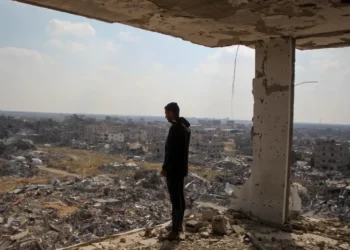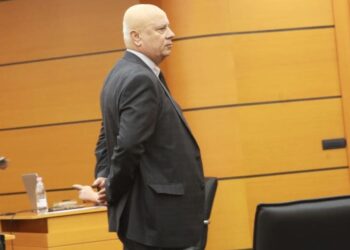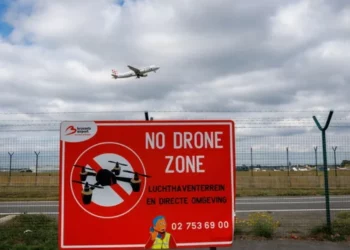By Sokol Çobo
Overlapping mining permits has produced clashes between criminal gangs for controlling chromium galleries in Bulqiza, causing a dozen killed and injured in the past decade, while the small, surrounded by mountains remains one of the poorest areas of Albania.
On January 21, 2014, at the Police Directorate of the District of Tirana, has been presented to voluntarily declare Gentian Kaçi, who 8 months ago had been shot dead by an assassination attempt at At. Zef Pllumbi in Tirana. Severely wounded during an assassination on April 4, 2013, Kaci told police officers he was already ready to identify the person he was shot.
Kaçi stated that the author of his wounding was Gjin Nika – at that time arrested by the police for illegal possession of weapons. Kaçi justified the late denunciation of Nika, showing that “he was afraid, according to him, the author had links to the police, the prosecution and the Bulqiza court.”
Although Kaçi’s testimony was supported by two of his wounded witnesses of injury, Alban Hysa and Shkëlzen Leka, on 25 February 2014, the Tirana Appeals Court relaxed the arrest warrant for Nikas as “a compulsion”.
Nika was a person with severe criminal precedents, and was suspected of being a charged killer. He was suspected of killing businessman Hysen Talja on January 17, 2014 near the Tirana Electric Market, which had a chrome gallery in Bulqiza. Nika has also been on the list of suspects for Shefqet Shehu’s murder in Bulqiza in 2013 – another chrome businessman – while being convicted of his brother’s injury.
However, on April 4, 2014, two weeks after being released from prison, Nika was shot dead near the Tapija Bridge in Fushe Kruja. In his assassination, he was killed and 33-year-old Fabio Xhunga, who was riding a motorcycle with Nika. Meanwhile, on December 5, 2014 Kavaja Street in Tirana was killed and Shkëlzen Leka, who witnessed against Nika.
According to police sources consulted by BIRN, this series of murders and assassinations is part of a long chain of crimes over the last decade – a result of the clash of criminal groups for controlling chrome galleries in the rich mining area of Bulqiza.
According to local police and prosecution sources, this crash became worse after 2005, when the center-right government of former Prime Minister Sali Berisha granted hundreds of exploitation licenses to the gallery in Bulqiza, which turned into conflict fire because they were often superimposed.
The data provided by BIRN shows that owners of these galleries have in some cases political ties, while sources at Bulqize police say that there are also convicted individuals and criminal groups.
“Bulqiza is planted with black hashish and the thirst for mafia or politics for this mineral has brought the slavery of miners,” says trade unionist Dilaver Kaloxha, while adding that miners are forced to work at the norm, under risky conditions and no one is declared guilty of frequent accidents at work costing their lives.
Although chrome galleries employ thousands of workers, Bulqiza’s mayor Melaim Damzi said mining revenue from the fossil is low and Bulqiza continues to be one of the poorest cities in Albania.
Bulqiza Concession
Chromium in the Bulqiza area has been identified since 1942. In 1948, surface mineral exploitation began on an area of 1 to 2 square miles and was worked on six mineralized outlets. In addition to surface utilization, in 1949 began the opening of underground research works to enable the start of exploitation in the underground landfill.
For the further intensification of the search and discovery work, in 1956, the Bulqiza Geological Enterprise started its activity, which paved the way for the development of the mine.
After the years 2000, the Bulqiza mine and the facilities built during the communist era passed through several hands.
On February 26, 2001, the Government issued a concession to the company “Darfo” Spa Italy for a concession to the company “Darfo” Spa Italy, after an unsuccessful proposal, the chrome mine and the enrichment plant in Bulqiza, together with the selection plant in Klos and the ferrochrome plant in Burrel.
The concession was signed by the then prime minister, Ilir Meta, while the Minister of Public Economy and Privatization was Mustafa Muçi. The duration of the concession would be 30 years.
“Darfo” founded the company “DARFO ALBANIA” on 14 April 2000. In July 2009, “DARFO” sells 100% of the share capital of the concessionary company “DARFO ALBANIA”, “ACR Holding” company and thereafter the name of the company is changed to “Albanian Chrome” with the same NIPT. On February 6, 2013, a “Albanian Chrome” announcement was signed at METE, where “ACR Holding” partners sold the “Balfin” 100% stake to “ACR Holding”.
It is learned that only the quotes of the company “ACR Holding” have been sold to “Balfin”, which has not changed the concessionary company “Albanian Chrome” and remains the concessionary company that continues to perform the activity defined in the agreement.
According to the Ministry of Energy, this agreement has transferred to the company “Balfin” all the obligations and rights of the concessioner provided in the Concession Agreement for the realization of the investment plan and the rehabilitation of concession facilities; for repaying liabilities to the government and third parties.
Search and Use Permissions
In addition to the concession, after 2005, the Ministry of Economy and Energy gave hundreds of exploration and exploitation permits for chrome in the outskirts of the city of Bulqiza. In this way, the area is separated by parcels.
BIRN has provided a complete list of all entities that have obtained permission to use chrome in Bulqiza district. According to the list compiled by AKBN, there are 117 such permits.
According to the Ministry of Energy, until the end of 2015, there were 264 mineral exploration licenses for chrome ore, of which three permits are concessional. These permits are distributed in 12 districts of the country and in two generations of ultrabasic rocks.
The largest number of usage permits, 117 permits or 47% of all usage permits, is located in Bulqiza district. In 2008, there were 68 operating licenses, while in 2013 this number had reached 118.
Official data from the Ministry of Energy show that dozens of licenses have recently been revoked, as there were overlapping parcels or galleries. According to the Ministry, at the moment of issuing permits, experts have mistaken the three-dimensional coordinates.
Another problem in the area is also the crossing routes (servitudes). According to reports by the Ministry of Energy, the granting of exploration and exploitation permits has led some galleries to have no way out, or to pass on parcels to other companies. Even the water pumps or power grid set up since communism has brought clashes between different societies.
The Ministry of Energy told BIRN that in the new mining law, endorsed at the end of 2014, Article 47 stipulates that a mining permit is revoked when it is ascertained that the licensed area has full overlap or partial overlap with a mining permit granted earlier in line with the legislation in force at that time.
In this case, the mining permit, which is given at a later time, is invalid for the overlapping area and the minister revokes it, only for the overlapping area. “In implementing this legal definition, Minister Gjiknuri has signed the full or partial revocation for overlapping of 20 mining permits,” official sources said.
A police officer who worked for a long time in Bulqiza, who did not want to be identified because of his duty still in the State Police, told BIRN that the conflicts in this area were caused precisely by the overlapping of parcels or galleries for research and use of chromium.
“The Mafia has managed to zap a few galleries, getting ‘tax’ to other companies,” said the officer.
According to him, in the last four years, a number of permits for exploration and exploitation of chrome have been granted in zone D, while dozens of subcontracting companies have been introduced.
The issuance of these unqualified permits has led for a number of years a great deal in the Bulqiza mine.
“We have information that individuals, convicted or suspected of serious crimes have taken control of some key galleries in the Bulqiza mine,” BIRN police officer told.
He adds that all this has been done with the support of some politicians, local or even central.
The same concern is shared by the syndicalist Perkoxha regarding the political or criminal strikes that protrude in the Bulqiza mine.
“Recently, the mafia with strong political support has managed to take control of one of the main galleries in D, from which it passes to all other galleries,” he said.
“The mafia of an important politician in Tirana is present in Bulqiza. This politician has been using this mine since 2001 when a concession was granted, “adds Prokoyaj.
Amulas at different levels of D sector have been added by court decisions that have brought overlapping.
Asked by BIRN, the Energy Ministry said in an official response that “it can not control the relations between these companies, as it only grants permission and it is up to the police to protect the lives of individuals or property.”
Bloody chrome
The concessionaire’s problems as well as the licensing of Bulqiza’s underground use over the last 15 years has brought a chaos into chromium utilization. Police reports over the years show that individuals with criminal records have managed to seize the gallery or are hired to save other galleries.
In 2009, according to state police, there was a clash between the tribes Ternova and Shehu, the owners of several galleries. Though they had blood ties between them, competition and disagreement degenerated into a massive beating in the city.
A few months later, in March 2010, the next incident occurred when Ilirjan Jangulli and his friends were allegedly robbed with a large amount of 700 tons of chrome worth at least 4 million new leks from the gallery of one of the rival groups . Jangulli is the owner of Kevger Sh.pk, and has permission to use in gallery 44 in sector D.
Then there were the quarrels and conflicts, including some clans, where each one acted for his business.
BIRN learned from State Police that the event of January 5, 2011 is known as the biggest conflict for the chrome battle. In official police press releases, Ilirjan Jangulli was accused of having shot fire in the center of Bulqiza town, and killed Fehmi Kërçuni. In the same crash, Shpëtim Reka and Eleonard Ndreu were injured.
At that time, police said the tribes Duriçi and Sheta collided. “Brothers Arben and Ardian Duriç were involved in the armed conflict where they were attacked by Jangulli, Destan Sheta and others,” sources of the State Police say.
According to them, on June 13, 2011, there is another criminal event, but this time outside the city of Bulqiza. In a bar in the former Blloku area in Tirana, Nadien Zeneli was killed and two of his friends were injured. Zeneli lived in Tirana, but had activity in the field of chrome. He was involved in the ventures of some businessmen in that area. On 29 June 2011, Tirana Police arrested Marigle Hakas as charged with the murder.
Conflicts between tribes Duriçi and Jangulli continued in 2012-2014. It is learned that Arben Duriçi and his brother Ardian Duriçi, owners of several galleries in area D, have been in collision with Ilirjan Jangulli of Destan Shetën. Police say that in a flat owned by tribe Duriçi was placed tritol in 2012 in Bulqiza, without any damage to people. Meanwhile, the Duriç brothers’ vehicle was explosive in Tirana.
The events will be relocated on January 17, 2013. After a police action in Tirana, the indicted Ilirjan Jangulli, who had been in international search for Interpol for two years, has been handcuffed after being charged with killing and stealing chrome in the Bulqiza mine.
He was charged with the murder of 5 January 2011 in the center of Bulqiza, where a casual miner, Fehmi Kërçuni and two members of the group, Shpëtim Reka and Eleonard Ndreu, were injured by the clashes of the two groups.
Meanwhile, on April 20, 2013, chrome businessman 40-year-old Shefqet Shehu was killed, while his brother Vehab Shehu was wounded. They were shot at a cafe just 200 meters from the Bulqiza Police Commissariat. For this event, Fadil Ternova was arrested, owner of several galleries. Everything was related to an old conflict that occurred in 2009, at the place called “Pishat”.
Police told BIRN that at that time, Vehab Shehu was seriously wounded by firearms from members of the Trnova family, although blood related. They had been co-owners of galleries until 2009 and later split, beginning conflicts over the control of Zone D.
Meanwhile, on 2 September 2013 was executed Qerim Marku, owner of several galleries and Sami Smeli was injured. Mark’s murder was suspected of his other rival, Gjon Nika and his group, but also of other clans with which he had conflicts. Dibra’s police have identified clashes between the years between the families of B. and E. Cupa, E. Kova, L. Trnovna, R. Duric, N. Shabani, F. and U. Tanci, as well as A. Shehu.
According to police reports, on January 17, 2014, Hasan Talja was executed on “Bajram Allaraj” street in Tirana. Again, police said the motive of the crime was the conflicts for the chrome business in Bulqiza with rival groups. For this event was questioned Gjin Nika and his group.
On January 24, 2014 Destan Gjeta was arrested. He was accused of killing a person and injuring two other people. I found, together with Ilirjan Jangulli, as one of the chrome businessman’s opponents, Arben Duriçi, while the family of the latter have been assassinated.
According to some reports by the State Police, conflicts over the Bulqize chrome galleries over the last years have caused 8 casualties and about 14 injured.
A prosecutor in Dibra, who spoke on condition of anonymity, told BIRN that the clash of criminal groups for zone D had come as a result of the overlapping of the galleries.
“Some strong locals are or have been ’employed’ as bodyguards of firms operating in that area, while they have collided with other strong ones, defending other companies,” the prosecutor said.
“In the absence of energy ministry decision-making over the years, or even suspicious court decisions, criminal groups have clashed with each other,” he added.
Links to politics
In addition to the concessionary company Balfin Group, owned by businessman Zamir Mane, there are some companies with strong political ties in Bulqiza, in the central and local administration.
Family members and relatives of the former mayor of Bulqiza until 2014, Mufti Duriçi, control two companies which have mining licenses for chrome; Duriçi shpk with administrator Hysen Duriçin and Kadurtex shpk, with administrator Kapllan Duriçin.
Deputies of Democratic Party MP Roland Keta, own three companies that have four mining licenses in the Bulqiza area.
Egi-K shpk operates in the B-section of zone D and has administrator Eduart Keta. IVNO 1100 Shpk, with administrator Gentian Keta, uses a source in Central Krka. Meanwhile, GENTARI sh.pk operates in gallery 38 at the Bulqiza mine and as administrator Gentian Keta.
In Bulqizë also operates a company associated with SMI deputy, Perparim Spahiu. Lubima Sh, p, k is owned by the deputy’s son, Luan Manjani.
Blood and Poverty
The production of chrome ore in Albania in 2005 was 170,697 tons, whereas in 2015 it shows 646,139 tons, about 63.55% or 410.622 tons of this production was carried out in the Bulqiza plant.
According to a proposal recently submitted to parliament, the government has agreed to postpone the concession deadline of the company “Albchrome” for 10 years. This bill is expected to be discussed in parliament.
Engineer Nexhbedin Marku told BIRN that currently concessionaire “Albchrome” has opened the well at level 17, which translates to a depth of 840 meters. According to estimates, the town of Bulqiza is about 820 meters above sea level, and currently miners are digging at a depth below sea level.
Mark says the work will go up to level 23, as well as in the traverbank Klos-Bulqizë. This working depth increases the difficulties of miners. It is learned that most of them are paid at a working rate, and a normal working day is estimated at about eight hours.
According to trade unionist Dilaver Kaloxha currently there are about 3,000 miners working in Bulqiza, Albchrome or even in other private companies. The guy, who has led the Bulqiza Miners’ Trade Union for four years, says that “the rate of miners depends on the distance, or the depth of the gallery. The average for a miner is the extraction of 3 chrome wagons. ”
According to the information collected over the years, the disorder says injuries are wiped out by the owners, while fatal accidents are purchased by the family silence.
“Miners, but also Bulqizë residents have faced real horror, extreme poverty, and blood,” the trade unionist said.
Pretty says that to date, there is no person convicted of work accidents.
“Death was bought by Lek. Events are never blurred. Always, the fault is the victim, “he says, while attacking the current Syndicate leaders.
“They do not make any reaction. Miners today are at the mercy of gambling and enslaved daily by the owners. Since the change of the owners of the concessionaire, the union has become their ‘property’, “he added.
Mayor Melaim Damzi shows that the Bulqiza mine nourishes about one third of the population of this area, which is estimated at 40 thousand inhabitants. Along with 3,000 miners, thousands of others are employed in mining services, such as hotels, restaurants or bars.
According to the Labor Office in the municipality of Bulqiza, 28 percent of the residents are unemployed.
Damzi says Bulqiza pays a high human cost for chrome, but the income it benefits is scarce.
“In 2015, the municipality of Bulqiza received 80 million ALL from the rent of mines. The state receives 4 percent of all chromium production. Meanwhile, the municipality benefits 5 percent of the 4 percent benefiting the state, “he said.
Although the mine is vital for Bulqiza’s economy, Damzi told BIRN that job accidents cost expensive taxpayers.
“Accidents at work, in addition to damaging the miners, have also become a problem for the Municipality, which should link pension to these miners,” the mayor concluded. Reporter.al














